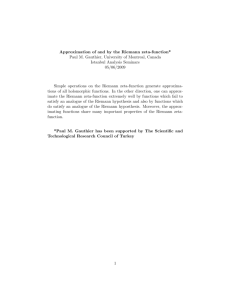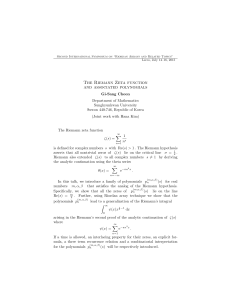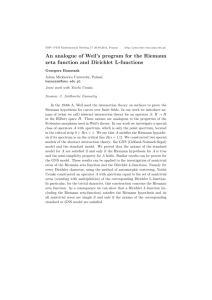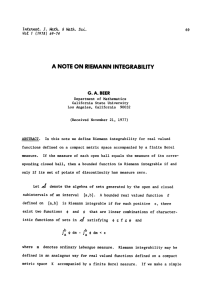Lecture No. 23
advertisement
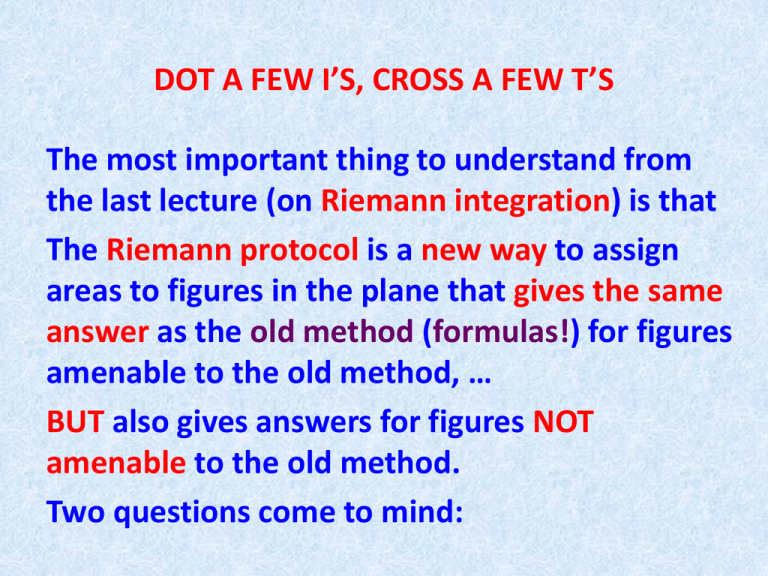
DOT A FEW I’S, CROSS A FEW T’S The most important thing to understand from the last lecture (on Riemann integration) is that The Riemann protocol is a new way to assign areas to figures in the plane that gives the same answer as the old method (formulas!) for figures amenable to the old method, … BUT also gives answers for figures NOT amenable to the old method. Two questions come to mind: A. We need a name for all those figures for which the Riemann protocol gives an answer (old and new). Since the figures are bounded by graphs of functions we will call the functions (we called them nice in the last presentation) Riemann integrable. B. Are all functions Riemann integrable ? This asks whether the Riemann protocol gives an answer for all C. Does the Riemann protocol enjoy the usual properties of area?, viz a. Monotone, i.e. b. Additive, i.e. Item B. raises the question: Which functions Riemann integrable ? are Unfortunately I cannot give you the complete answer (I could, but it would be meaningless to you, you’ll learn it when/if you will take Real Analysis.) However, here is a quite satisfactory answer: Theorem. If is I. Bounded, i.e. II. Discontinuous only at a finite number of points then f is Riemann integrable. Additionally, I can give you (without proof) an example of a function that Is NOT Riemann integrable (the protocol fails) Here is the example: (hard to graph, discontinuous everywhere !) This function is known as the Dirichlet function (Wikipedia!), from its ideator Peter Gustav Lejeune Dirichlet and is one of many examples where the Riemann protocol does not give an answer. Somebody eventually developed a new protocol that gives the same answer as Riemann’s for Riemann integrable functions, but also handles this one and others. The somebody is Henri Léon Lebesgue. (Wikipedia!) Of course, Lebesgue protocol is known as Lebesgue Integration His work dates to very recently (in mathematical time, think of Euclid!), circa 1905. It gives 1 as the answer for the Dirichlet’s function. END OF HISTORICAL DISCOURSE There are still a few t’s to cross, namely a symbol for the answer provided by Riemann’s protocol, and a few additional convenient properties. Remember that We are dealing with a function The symbol for the answer is the well known (read as “the integral from a to b of “. The usual properties of area, as well as some more computational devices, are contained in the following list, provided by Prof. Pilkington (note that #3 we just did in class, #7 and #8 express what we have called monotonicity, and #1 is a convention to make #6 work in all cases.) (courtesy of Prof. Pilkington) One last detail: What do we do with an arbitrary (not necessarily positive, but nice) function like this one? Intuitively we want to say add the “positive” area” + the “negative” area. We make our intuition formal (and clever !) in this way: For any nice function define and Convince yourself that . A figure might help. The original The two pieces: ( is the violet line, the red line.) Both and negative part of are positive. ( is the f flipped over. Therefore we define Of course, by definition, and Now do lots of Riemann sum examples.

